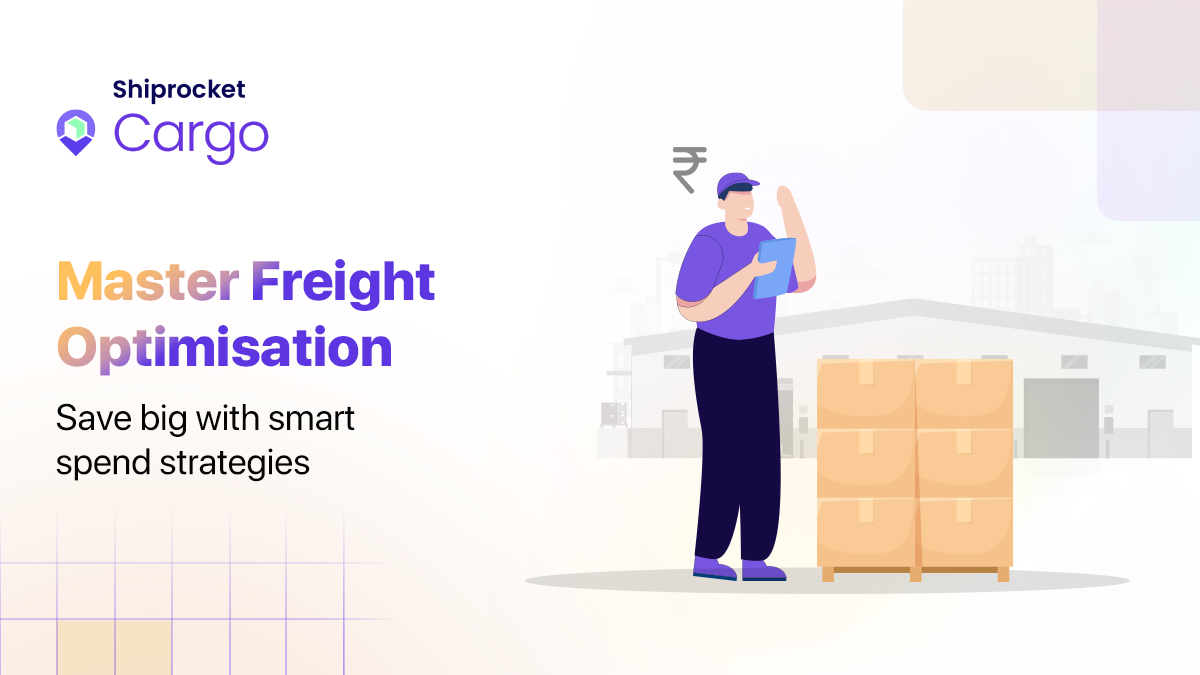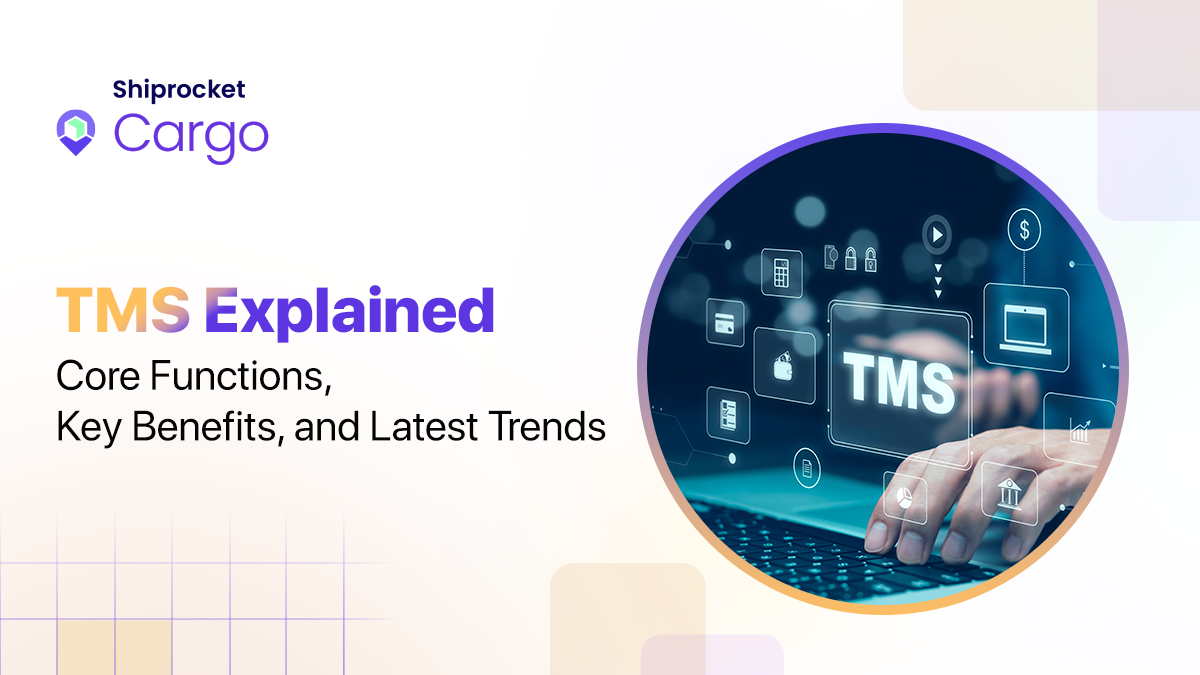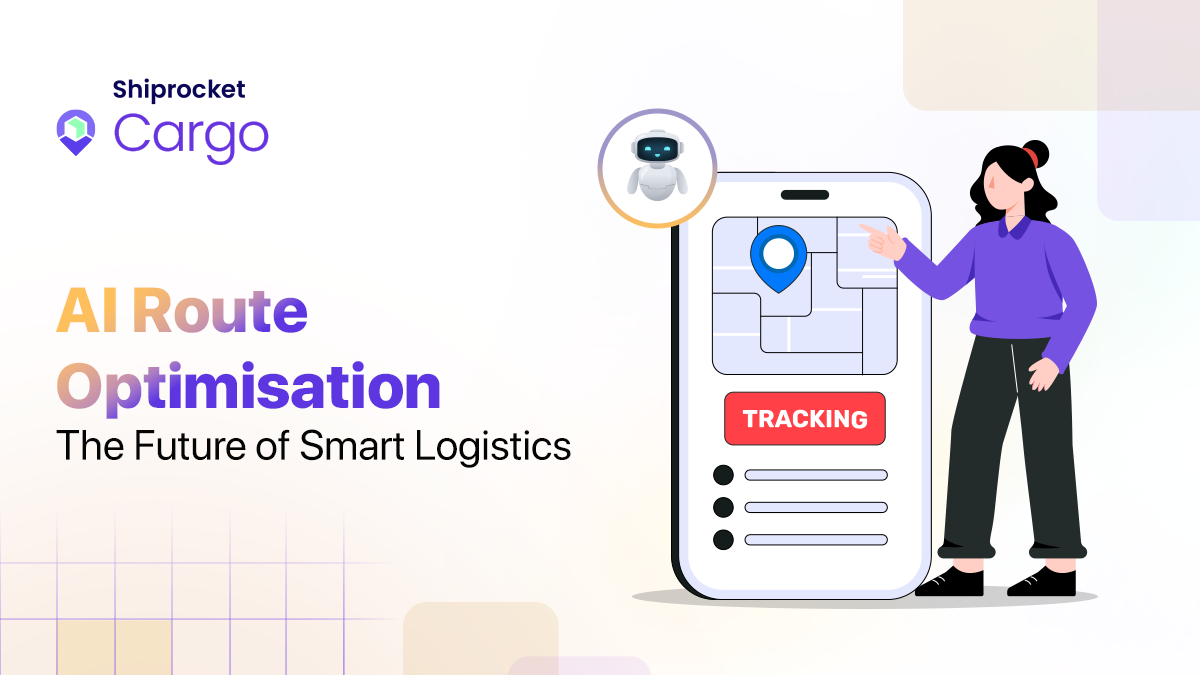Supply Chain Transparency: 7 Ways to Win Deep, Long-Term Customer Trust
- What is Supply Chain Transparency?
- What’s Driving the Surge in Transparency Expectations
- Elevating CX Through Transparent Operations and Branding
- Technology’s Crucial Role in Enabling Visibility and Trust
- Putting the Customer at the Center of Brand Transparency
- Common Roadblocks to Achieving Full Supply Chain Visibility
- Making Transparency a Strategic Edge in Crowded Markets
- Shiprocket Cargo: A Trusted Partner for Transparent Logistics
- Conclusion
Did you know that 65% of your customers are likely to switch to a different brand if it offers more transparency about the origin of its products and the overall supply chain? This report is sufficient to suggest that to earn your customers’ trust, you must provide them with visibility into the production process, raw material sourcing, and other aspects of the supply chain.
In fact, customers are even ready to pay 2% to 10% more if you offer greater supply chain transparency, according to the MIT Sloan School of Management. Customers not only buy your products, but they also buy the stories behind those products and your brand values. Supply chain transparency can help you meet your customers’ expectations and build long-lasting loyalty.
This blog will explore some of the most effective ways to ensure supply chain transparency, how to earn your customers’ trust and maintain it for a long time.
What is Supply Chain Transparency?
Supply chain transparency means giving customers, partners, and regulators a clear view into how your products are made, sourced, and delivered. It is about openly sharing information across every stage of the supply chain, from the origin of raw materials to the final delivery. Transparent brands use this visibility to build trust by showing their commitment to ethical practices, sustainability, and accountability. In today’s market, customers want to know the full story behind what they buy. Supply chain transparency helps you tell that story with honesty and confidence.
What’s Driving the Surge in Transparency Expectations
- Consumer awareness is reshaping your supply chain. Today’s buyers demand more than low prices and fast delivery. They want to know how, where, and by whom their products are made. This shift in behaviour is the primary force behind rising transparency expectations across global supply chains.
- Digital access further fuels this demand. Social media, mobile apps, and smart packaging allow customers to discover and analyse data in real time. If your supply chain lacks clarity, you risk losing trust and business to competitors who openly share their sourcing, labour, and sustainability practices.
- Regulatory pressure adds urgency. Governments across Europe, North America, and Asia are enacting laws mandating disclosure around labour conditions, emissions, and sourcing. If your supply chain operations don’t meet these compliance standards, penalties and reputational damage may follow.
- Ethical investing and brand scrutiny intensify. Stakeholders, including investors and partners, now favour companies with transparent, ethical operations. Brands seen as opaque face investor pullback, negative press, and public backlash.
- ESG (environmental, social, and governance) enable organisations to drive internal change. It means that when you set ESG goals, it creates pressure to improve internal operations. To meet sustainability benchmarks, you need full visibility across how you manage and monitor your supply chain. Without transparency, setting, tracking, and reporting ESG goals becomes almost impossible, which damages credibility in the process.
Supply chain transparency is no longer optional, as some businesses might believe. It’s a strategic, ethical, and operational requirement that drives customer loyalty, regulatory compliance, and long-term resilience.
Elevating CX Through Transparent Operations and Branding
Customer expectations have evolved. You’re no longer judged solely by product quality or price. Today’s consumers care about how your product gets made, where it comes from, and whether the people and planet were treated fairly along the way. Supply chain transparency is a long-term trust-building strategy and not just a marketing trend.
Here’s how you can elevate customer experience by incorporating transparency deep into your operations and branding:
Give Customers Visibility into the Product Journey
Start by mapping your supply chain and identifying each touchpoint, from raw materials to final delivery. Then, share that journey with your customers in plain language. You can use visual content and interactive elements, like videos or QR codes, on product packaging to inform your customers about your sustainable sourcing practices.
When customers can trace the origin of their purchase, you build credibility and create an emotional connection. It’s essential to keep your customers informed because this will make them feel empowered and respected. Eventually, this can help you boost customer satisfaction and loyalty.
Use Transparency to Set Your Brand Apart
Supply chain transparency should be the central messaging of your brand because your supply chain is already an important part of your brand’s narrative. Communicate openly about your sourcing standards, labour practices, carbon footprint, and ethical commitments. Highlight certifications, third-party audits, and supplier partnerships that reinforce your claims. Don’t wait for your customers to ask, but proactively show them what your brand values are. In saturated markets, transparency helps you cut through the noise and win value-aligned buyers.
Turn Honest Disclosures into Long-Term Trust
Instead of aiming for perfection, focus on progress and honesty. Share both successes and challenges. If your supply chain isn’t yet fully ethical or sustainable, be transparent about it and outline your roadmap. Customers respect companies that acknowledge their gaps but demonstrate a consistent effort to improve. This kind of openness builds long-term trust, not just momentary goodwill. Customers stay loyal to brands they perceive as honest and accountable.
Make Transparency an Everyday Experience
Integrate transparency into every customer interaction. Ensure your website, product labels, emails, and customer service touchpoints offer clarity, consistency, and traceability. Train your customer-facing teams to speak confidently about your supply chain story. Supply chain transparency should be felt, not just read. When transparency is part of every touchpoint, it feels authentic.
Leverage Tech to Enhance Real-Time Trust
You can invest in different traceability tools and technologies like blockchain, RFID, supply chain analytics, and more. These technologies let you provide real-time updates about your product’s status and origin. Use apps, dashboards, or online portals where customers can track their product’s journey. Make it simple, visual, and informative. Real-time transparency in the supply chain eliminates doubts and creates a premium user experience.
Technology’s Crucial Role in Enabling Visibility and Trust
Technology gives you the tools to tell your customers what happens behind the scenes. It turns opaque, fragmented supply chains into transparent ecosystems where accountability thrives. Here’s how:
- Real-Time Tracking Builds Immediate Confidence: You can use GPS, RFID, and IoT sensors to offer real-time shipment visibility. When customers know where their orders are, they feel in control. It minimises anxiety and reduces service inquiries. More importantly, it shows you respect their time and money.
- Blockchain Ensures Data Integrity: You can’t gain trust if your data can be altered or questioned. Blockchain fixes this. Logging every transaction in an immutable, time-stamped ledger creates a single source of truth. This is especially important in industries like food, fashion, and pharmaceuticals, where origin, safety, and ethical sourcing matter.
- AI and Predictive Analytics Reveal Risk Before It Hurts: Technology helps you see ahead. AI-powered analytics flag bottlenecks, disruptions in supply chains, and potential delays before they escalate. You can communicate proactively with customers, offering alternatives or solutions. This level of foresight builds trust, and it shows you’re thinking ahead for them. This proactive use of AI also feeds directly into supply chain optimisation, allowing you to fine-tune routes, inventory levels, and sourcing strategies in real time to reduce waste and keep commitments on schedule.
- Cloud-Based Platforms Align Stakeholders: When you centralise supply chain data in a cloud-based platform, everyone, including suppliers, manufacturers, and distributors, works from the same playbook. This reduces friction and miscommunication. Customers benefit because your fulfillment becomes faster, more reliable, and visibly well-managed.
- Digital Audits Prove Ethical and Sustainable Practices: Modern consumers care about ethics. Using digital tools to audit and certify labour conditions, carbon footprints, and material sourcing gives you proof, not promises. You can share this data openly, turning transparency into a competitive advantage.
- Dashboards Turn Data Into Trust: Instead of just collecting data, share it by offering order histories, sustainability metrics, or sourcing details. Your customers are more likely to trust your brand when they see what you see.
Putting the Customer at the Center of Brand Transparency
To earn deep, long-term trust, put your customer first in every transparency effort. You should answer your customers’ biggest question, and that is ‘Why should I trust this brand?’
- Start with clear, customer-relevant information. To do this, you have to go beyond disclosing facts. You must connect them to what your audience values. Whether it’s ethical sourcing, environmental impact, or fair labour, show how each step in your supply chain aligns with your customers’ expectations and beliefs.
- Offer visibility that’s easy to access and understand. Provide supply chain data in plain language. You can do so through product pages, QR codes, or interactive dashboards. Supply chain transparency shouldn’t be a research project for your customers, and that’s why it’s essential for you to simplify the journey.
- Let customer feedback guide transparency and visibility. Use customer insights to shape what data you disclose. If customers care about packaging waste or local sourcing, make those points prominent. This shows you’re listening to your customers, and that can help you build trust faster.
- Be honest, even when your supply chain operations are imperfect. If your supply chain has gaps or ongoing challenges, acknowledge them. Show what steps you’re taking to improve. Customers trust brands that tell the truth, not those that only promote polished versions of reality.
- Don’t forget to enforce transparency with consistency. You must align your brand’s messaging, practices, and policies across all touchpoints. Inconsistencies break trust fast. Keep your brand voice clear and your commitment visible, from marketing to manufacturing.
Common Roadblocks to Achieving Full Supply Chain Visibility
You may face several challenges while achieving full transparency and visibility into your supply chain operations. These challenges can make it difficult to track goods, ensure ethical practices, and manage risks effectively.
- Data Silos and Fragmentation: Businesses often have data stored in disparate systems, making it difficult to get a holistic view of the supply chain. This can hinder collaboration and decision-making.
- Lack of Standardisation: Inconsistent data formats and protocols across different parts of the supply chain can make it challenging to integrate data and gain a unified perspective.
- Limited Technology Adoption: Some companies may be hesitant to adopt new technologies or may lack the necessary infrastructure to support real-time data tracking and analysis.
- Complex Global Networks: Managing international supply chains with multiple suppliers and intermediaries adds to the complexity of tracking goods and ensuring transparency.
- Lack of Real-time Data: Many companies struggle to get real-time data on their supply chain operations, which is crucial for making informed decisions and responding to disruptions quickly.
- Inefficient Communication and Collaboration: Poor communication and collaboration between supply chain partners can create bottlenecks and delays, making it harder to achieve transparency.
- External Factors: Geopolitical events, natural disasters, and other external factors can disrupt supply chains and make it challenging to maintain visibility.
- Cost and Resources: Implementing new technologies and processes to enhance supply chain visibility can be expensive and resource-intensive, especially for smaller businesses.
- Cybersecurity and Data Privacy: Sharing sensitive supply chain data among different stakeholders raises concerns about data security and privacy.
- Regulatory Compliance: Many industries are subject to strict regulations regarding sourcing, environmental impact, and labour practices, making it crucial to have a clear view of the supply chain to ensure compliance.
- Resistance to Change: Some stakeholders may resist the idea of sharing information or adopting new technologies, making it harder to achieve transparency.
- Collaboration with Suppliers: Gaining the cooperation of suppliers and other partners to share data and collaborate can be challenging, especially when they have concerns about sharing proprietary information.
Making Transparency a Strategic Edge in Crowded Markets
In crowded markets, businesses can gain a strategic advantage by prioritising supply chain transparency. By being open about their operations, organisations can build trust with consumers, foster stronger supplier relationships, and reduce risks. Transparency also allows for proactive risk management, helping businesses identify and address potential disruptions before they escalate. Sharing information and collaborating on strategies to mitigate risks can enable your business to improve supply chain resilience, ensuring smoother operations and faster recovery during disruptions. Here’s how supply chain transparency can be a competitive advantage:
Building Trust and Brand Loyalty
Consumers increasingly demand socially responsible products, and transparent supply chains demonstrate a commitment to ethical labour, environmental sustainability, and human rights. By showcasing their efforts in transparency, brands can enhance their reputation and build trust, leading to increased customer loyalty and brand advocacy. Transparency allows brands to connect with customers on a deeper level, demonstrating their commitment to social and environmental values.
Proactive Risk Management
Transparency provides visibility into the entire supply chain, enabling businesses to identify potential risks and bottlenecks before they impact operations. By having clear communication and collaboration with suppliers, companies can quickly respond to disruptions and mitigate their impact. Proactive risk management through transparency can help businesses minimise the impact of unforeseen events and ensure business continuity.
Strengthening Supplier Relationships
Supply chain transparency not only builds customer trust but also fosters credibility and collaboration among suppliers. This leads to stronger partnerships and more efficient operations. Open communication about risks, challenges, and opportunities enables suppliers to work together to find solutions. Sharing information and collaborating on strategies to mitigate risks can enable your business to improve overall supply chain resilience.
Meeting Regulatory Requirements and Consumer Demands
Transparency helps businesses comply with evolving regulations and meet the growing demand for socially responsible products. Transparent supply chains are crucial for improving ESG performance, attracting investors and enhancing overall corporate image. By taking proactive steps to ensure supply chain transparency, businesses can gain a competitive advantage in the market and stand out from competitors.
Shiprocket Cargo: A Trusted Partner for Transparent Logistics
Shiprocket Cargo is a tech-enabled, transparent, and scalable B2B cargo shipping solution that simplifies the process of bulk and heavy shipments across India. With over 24,000 pin codes covered and 2,000+ happy clients, we can help manage large consignments, save costs, and prioritise time-bound deliveries. We also adapt to your unique business needs with smart automation, real-time tracking, AI-powered courier recommendations, seamless ERP integration, and other advanced features.
Here are some reasons why you should choose Shiprocket Cargo:
- Affordable Shipping Rates: Deliver your cargo shipments affordably with shipping rates starting at just Rs. 350 per 20 kg.
- Nationwide Reach: Ship to 24,000+ pin codes across India effortlessly.
- Flexible Shipment Options: Choose from FTL, PTL, LTL, or Air Cargo based on your load and urgency.
- AI-Powered Courier Selection: Optimise delivery with intelligent partner recommendations.
- 24/7 Support: Get help whenever you need it, with real-time assistance and updates.
- Up to 40% Cost Reduction: Reduce logistics spend with smarter, tech-first shipping decisions.
- Real-Time Tracking: Monitor your shipments from pickup to delivery.
- Quick Commerce Ready: Schedule appointment deliveries for FMCG products by partnering with DMart, Metro, and JioMart.
- Time-Bound Deliveries: Deliver even during off-hours (11 PM – 8 AM) to stay ahead.
- Seamless API Integrations: Effortlessly sync with leading ERP platforms like SAP, Navision, and more.
- Value-Added Services: Enjoy features like ePODs, NDR resolution, and weight dispute redressal.
Using Shiprocket Cargo is super easy. You just have to follow the 3 simple steps below.
- Create a shipment
- Select a courier partner with AI recommendations.
- Ship your parcel
Conclusion
Winning customer trust isn’t a one-time action. It’s a continuous process, especially maintaining their trust in your brand. Making your supply chain transparent shows your customers that your brand values ethics, accountability, and real human impact. This honesty and visibility ensure long-lasting loyalty that no marketing campaign can buy. When your customers know what’s behind the product, they’ll choose your brand, again and again, over your competitors.



